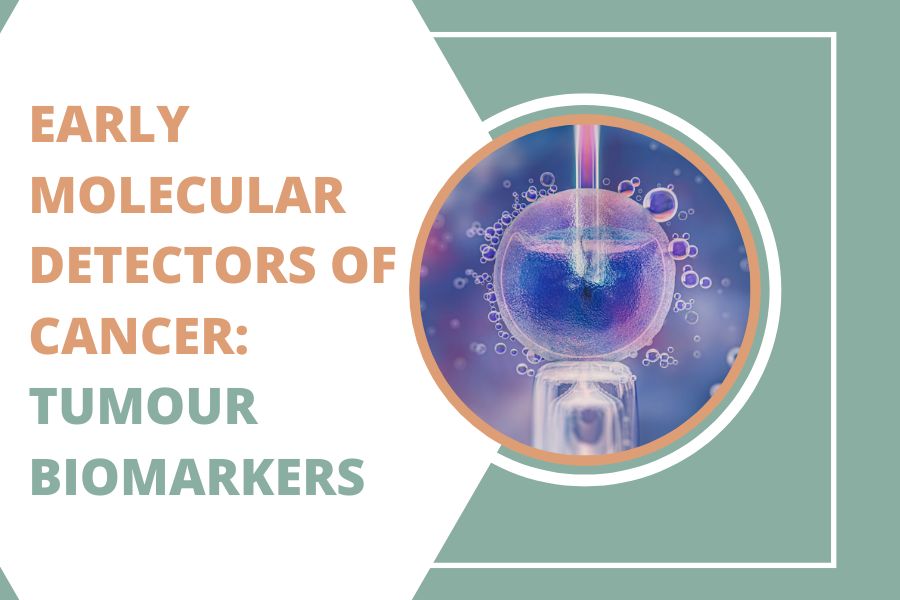Cancer is often described as ‘a silent killer’ or ‘ticking time bomb’– and unfortunately, both of these terms ring true. According to the International Agency for Research on Cancer, it remains a leading cause of death worldwide, claiming nearly 10 million lives in 2022 alone. One of the greatest challenges in combating this disease is that it frequently goes undetected until symptoms become apparent, which is often at an advanced stage, where treatment options are limited and survival rates drop significantly. This makes the need for early detection all the more urgent, as confirmed by the WHO.
So, how can we detect a tumour before it is even visible on a scan? The answer lies in an essential component of modern diagnostic medicine: biomarkers. I had the opportunity to explore these first-hand during my recent observership at Apollo Hospital’s Biochemistry Department.
Introducing You to the Body’s Early Warning Signals
Biomarkers are measurable characteristics of the body that behave as indicators of a disease, a change in normal biological processes, or the body’s response to external stimuli. These can range from physical signs like blood pressure to molecular ones like proteins, genes, and hormones. In clinical practice, specific biomarkers are associated with specific diseases. For instance, blood glucose levels are used in the diagnosis and monitoring of diabetes; elevated troponin levels signal myocardial infarction; prostate-specific antigen (PSA) aids in detecting prostate cancer; and BRCA1/2 gene mutations indicate a genetic predisposition to breast and ovarian cancers. Depending on the type of biomarker, their detection techniques can vary from simple measurements made at a check-up to laboratory tests of blood, urine, or tissues. After this, the results are compared to reference ranges, which are a specific set of values within which a healthy person’s biomarker levels are expected to fall.
The applications of biomarkers are broad, including early disease detection, monitoring the effectiveness of pharmacological treatments, detecting recurrence, and tracking disease progression. Based on their use, they are classified as susceptibility, diagnostic, prognostic, monitoring, predictive, response, or safety biomarkers.
The Role of Biomarkers in Detecting Cancer
Let’s first define a tumour: an abnormal, excessive growth of tissue that can be either benign (non-cancerous) or malignant (cancerous). The latter involves a group of diseases where abnormal cells grow and spread uncontrollably, destroying surrounding tissues.
A tumour biomarker is a substance synthesised by tumours or other body cells in response to cancer and released into circulation. These can be proteins, enzymes, hormones, antigens, antibodies, nucleic acids, or metabolites resulting from abnormalities in set points or deregulated metabolism.
One of the most widely used categories of tumour biomarkers is tumour antigens, which are proteins or glycoproteins present on the surface of cancer cells or secreted into the bloodstream. They fall into two major types: tumour-specific antigens (TSA) and tumour-associated antigens (TAA). TSAs are found exclusively in cancer cells and are highly specific to certain cancer types. In contrast, TAAs are present in some normal or diseased tissues but are abnormally or significantly overexpressed in malignant cells. To be clinically useful, their expression must be distinguishable from baseline levels in healthy cells.
Examples of tumour markers include:
- hCG (human chorionic gonadotropin): A glycoprotein hormone normally produced by the placenta during pregnancy, but ectopically produced by certain germ cell tumours and trophoblastic diseases (like choriocarcinoma).
- CA-125 (cancer antigen 125): A TAA glycoprotein often elevated in epithelial ovarian cancer.
- CTCs (circulating tumour cells): Cancer cells that have detached from a primary tumour or metastasis and entered the bloodstream provide real-time information on tumour burden and mutations.
To increase diagnostic accuracy, facultative tumour markers are often used in conjunction with principal markers: substances that are not specific to cancer but that may be elevated in malignancies. These are especially helpful in ambiguous diagnostic scenarios. For example, CA-72.4 might also rise in ovarian cancer and can provide supplementary diagnostic value to CA-125.
Not only do tumour biomarkers help in diagnosis and staging, they’re also used in prognosis, cancer treatment planning, and monitoring treatment response!
From Blood to Data: The Technology Behind Detection
During my time at Apollo Hospital, I had the privilege of receiving fascinating insight into the behind-the-scenes of the detection of tumour biomarkers in a laboratory, from sample collection to technological analysis.
Step 1: Blood Sample Collection
The first step is collecting data from the patient in the form of a blood test. Although tissue biopsies can offer higher accuracy, blood tests are far less invasive and more accessible. Moreover, blood is preferred over urine as it maintains a more stable pH and is less susceptible to dilution or interference from extraneous variables.
Each blood sample is collected in a tube and marked with a unique QR code that aids in both efficiency and patient anonymity.
Step 2: Detection Test Using Technology: Immunoassay Analyser
The detection and quantification of specific biomarkers, both antigenic and hormonal, are carried out using immunoassay antigen-antibody analyzers. I observed a model named Cobas e 411. Each biomarker, and thus every cancer test, requires a dedicated reagent kit containing antibodies precisely engineered to bind exclusively to their corresponding antigens.
Sample tubes are automatically processed by the machine, where 20 μL of sample reacts with the antigen-specific antibodies to form a ‘sandwich complex’. This binding triggers a chemiluminescent signal, detected by a photomultiplier and converted into measurable data. The system is finely calibrated using a two-point curve generated from scanned reagents to detect subtle biomarker variations, enabling precise molecular-level analysis.
Analysers are often preferred over other techniques like ELISA, CLIA, or mass spectrometry because of higher affordability, sensitivity, and operational ease, especially in large hospitals.
Limitations of Tumour Biomarkers as a Diagnostic Tool
Despite their utility, tumour biomarkers are fallible: Variability in sensitivity and specificity can lead to false positives or negatives, while individual differences make it challenging to define universal reference ranges. Analytical inconsistencies and the limited reliability of biomarkers as standalone diagnostic tools further complicate their use. However, as precision medicine continues to evolve, the role of biomarkers is only expected to grow.



